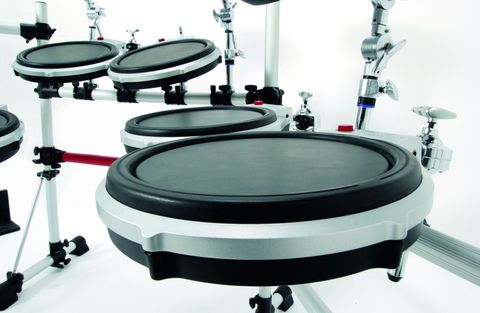There is no denying the profile of the DTX brand and, as the flagship model, the Xtreme IIS has the job of, well, flying the flag for the whole range. As one of the runners in what is pretty much a two-horse electronic percussion race, Yamaha placed great store on the success of this e-kit.
While it might horrify environmentalists, the amount of literature shipped with Yamaha's DTXtreme IIS is breathtakingly impressive. So massive is the kit's user manual that it almost acts as a deterrent to actually getting stuck in and learning the ins and outs of the module. It certainly helps create the impression of the DTXtreme IIS as being a powerful, complex proposition, though.
Serious set-up
What is immediately clear when you come up against the Xtreme IIS for the first time is that it is an arresting-looking beast. Leaving opinions about rubber pads versus mesh heads to one side for the moment, the five-pad, three-'cymbal' and hi-hat array looks very proper. This alone is enough to arouse interest from those considering a kit for live use.
The generously sized snare and tom pads (the TP100 toms are 10", the TP120SD snare is 12") and the businesslike RS-150 rack are imposing enough to get close to the feeling of being surrounded by the kit, as opposed to being perched behind a collection of over sized switches, and the fact that the RHH130 hi-hat pad mounts on a normal hat stand only adds to the grown-up feel.
Of course, the arguments for and against rubber pads like these (compared to mesh heads) will rage forever. Those unconvinced by rubbery types will probably dismiss the DTXtreme on those grounds alone but the size and construction of the Yamaha pads that make up this kit mean they are very usable, and are forgiving enough to be perfectly playable for extended periods. The build quality of the die-cast-based pads is exemplary, as we would expect from the Japanese giant.
Although the complete DTXtreme package is extensive once you've factored in the rack, seven cymbal and tom mounts, the pads and the brain itself, assembly is relatively pain-free. Each of the cables that run between pads and head is clearly labelled, and a plastic 'cable snake' in which to stow all the wiring is also included to tidy things up.
It takes a while to get things into shape when you grapple with individual clamps and rack legs for the first time, but regular Xtreme giggers will soon have their own set-up routine down pat. And a fair percentage of users will probably only ever use the kit in a fixed location for practice purposes.
Modular magic?
There's much that's agreeable about the physical attributes of the DTXtreme. But of course the pads and rack are only half the deal, and they're nothing without the brain. The Xtreme sound module is home to more than 2,000 voices, created by a 16-bit AWM2 tone generator and organised into 90 factory preset drum kits (40 user programmable kits are also available).
On top of the basic sonic capabilities, the device also acts as a sampler (with 8Mb of memory on-board) and a two-track sequencer. The choice of sounds on offer is typical of a modern drum module - there's a wide range of acoustic-emulating kits varying from slick 'studio session' sets with tight, bright toms to chunkier arena rock choices with depth-charged bass drums and snares.
Then there's a mass of ethnic percussion sounds covering all manner of world music genres from Latin and Indian to Japanese flavours. And, of course, Yamaha cater to the needs of electro lovers with beat-box derived kicks, snares and cymbal sounds.
Sound judgement
Assessing the quality of electronic drum sounds is an area fraught with difficulty - it is obviously subjective, and influenced by the fact that sounds can be tweaked to alter them far beyond their original state. But try we must to give an idea of the nature of the DTXtreme IIS.
So we'll say that the majority of acoustic kits are pretty decent, with a tendency to sound quite produced (in as much as they give the impression of a sheen of studio compression and EQ), and that we really liked some of the ethnic stuff. There is, however, a lack of dynamic three-dimensional character to much of what's on offer, and as such the out-of-the-box sound of the Xtreme isn't as engaging as that of some (admittedly more expensive) electronic kits we have come across.
It's great for workaday tasks - practice, rehearsals, songwriting (surely the most common uses for such set-ups) - but lacks that magic sparkle to make it really special.
A couple of issues really drag the DTXtreme down, unfortunately. Perhaps the hardest to work around is the way in which the hi-hat works and feels. The fact that it mounts on a proper hi-hat stand should be a real boon, but it just comes across a bit clunky.
Admittedly extremely difficult to recreate accurately, that 'in-between' half-open hat sound eludes the Xtreme almost entirely - the leap between tight-shut and completely open is too, ahem, extreme and means that subtle hi-hat stuff is pretty much impossible.
The DTX range has won lots of fans for Yamaha over the years and with good reason - the kits are well priced and offer real functionality. The DTXtreme IIS sticks to the theme in terms of its capabilities and relative affordability; its physical attributes are appealing and it feels better to play than kits with smaller playing surfaces.


